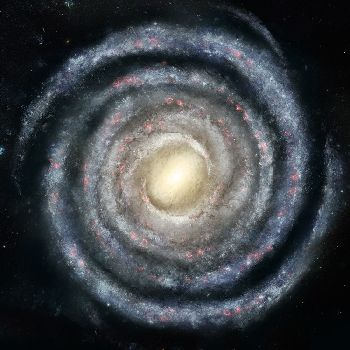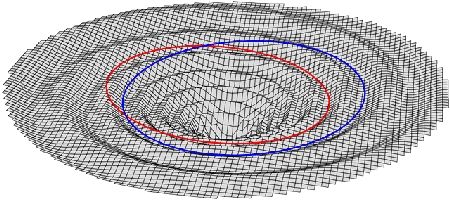
Publisher:
Bonnie King
CONTACT:
Newsroom@Salem-news.com
Advertising:
Adsales@Salem-news.com

~Truth~
~Justice~
~Peace~
TJP
Dec-10-2009 00:17

 TweetFollow @OregonNews
TweetFollow @OregonNews
Milky Way Gets a Makeover
Salem-News.comIndependent Researchers Solve Galactic Mystery.
 Artist Credit: Melaina Mace |
(HASTINGS, UK / ASHLAND, Ore.) - Spiral galaxies are among the most beautiful and familiar objects in the heavens, but a working explanation as to why galaxies evolve into spirals has eluded astronomers for decades.
Now, two independent researchers have published a compelling solution to this eighty year old problem, which appears in the November 2009 issue of Proceedings of the Royal Society A.
Consequently, the Milky Way must be remapped. This newly emerging picture of our galaxy is being released online today as a high‐resolution digital image.
The Milky Way is revealed as tightly wound “grand design” two‐armed spiral – not a four‐armed spiral as has previously been supposed.
Independent mathematician Charles Francis of Hastings, U.K., and amateur astronomer Erik Anderson of Ashland, Oregon, had been working on a quite different problem when the discovery was made. Anderson had compiled data from existing sky surveys on more than 20,000 Milky Way stars with accurately known positions and velocities. By treating orbits as precessing ellipses, Francis found that mutual gravitation naturally leads to orbital alignments that generate spiral patterns. Orbital motions follow spiral arms over large distances.
Francis likens the gravitational potential of a spiral galaxy to a giant funnel with spiral grooves. Stars, like rolling marbles, are channeled along the grooves until they build enough momentum to escape. Escaping stars migrate away from the galactic center, crossing over the next highest groove, and falling back into the same groove they came from.
Francis and Anderson’s model also explains why spiral patterns are stable. As an arm accumulates stars, its gravitational field grows stronger, making its “groove” deeper and drawing greater numbers of stars into it. Thus, mutual gravity between stars reinforces spiral structure. The gravity of the arms locks the rate of orbital precession to spiral pattern speed (which rotates slowly backwards) for a wide range of orbits. Interstellar gas, following similar motions, also contributes to the formation of “grand design” two‐armed spirals.
 Spiral Structure Courtesy: rqgravity.net/ |
“The idea is so simple that I had initially rejected it,” Francis confesses.
“I thought that if it were right, it would already be known; but when I compared it to data, it worked straight away, giving a perfect fit.”
Astronomer Rainer Klement, at the Max Planck Institute for Astronomy in Heidelberg, Germany, agrees. “It is a very nice paper with very good ideas and explanations for the kinematic structures we observe,” Klement remarks.
“It comes up with an elegant way of explaining the velocity distribution in the solar neighborhood.” Klement believes that future observations, covering even broader regions of the galaxy with even greater precision, will support the paper’s conclusions.
The introduction of a working model for spiral galaxies will revolutionize the study of galactic dynamics. “It comes as a surprise to most people that galactic orbits of stars are still treated in textbooks using a model of epicycles introduced in the 1920s,” Francis notes. “Epicycles are generally believed to have been banished from astronomy over three hundred years ago, when Newton explained Kepler's discovery that planetary orbits are ellipses.
In popular culture, ‘adding epicycles’ refers to the process of introducing fudges to make a theory fit data, when actually the theory needs to be replaced in its entirety.”
Articles for December 9, 2009 | Articles for December 10, 2009 | Articles for December 11, 2009


Salem-News.com:


googlec507860f6901db00.html
Terms of Service | Privacy Policy
All comments and messages are approved by people and self promotional links or unacceptable comments are denied.
Daniel Johnson December 10, 2009 4:43 pm (Pacific time)
It's what's called a paradigm shift in Thomas Kuhn's groundbreaking book The Structure of Scientific Revolutions. It means that people have a certain way of looking at things but as contradictory evidence accumulates, you add “epicycles” so the whole thing can still hold together. But over time, the system becomes increasingly unwieldy, until the picture has to change which is called a paradigm shift. The most famous example is the belief in an earth-centred universe. If the earth were at the centre of the solar system the moon, Sun and planets should follow certain paths in the sky. But they don’t. In order to explain the discrepancies, epicycles were added as needed. Eventually the system collapsed and it had to be acknowledged that the Sun was at the centre. In later centuries it became obvious that the Sun wasn’t even at the centre of the universe.
One interesting aspect of paradigm shifts is that once you’ve made the shift, you can’t go back. Once you see that the Sun is the centre of the solar system, you can never see the solar system with the earth at the centre again.
We can put that in everyday terms. You know a young man who seems angelic. The perfect gentleman with no vices. Then one day you accidentally run into him in a bar where he is smoking and drinking. That precipitates a paradigm shift for you and you can never see him as angelic, again.
[Return to Top]©2025 Salem-News.com. All opinions expressed in this article are those of the author and do not necessarily reflect those of Salem-News.com.